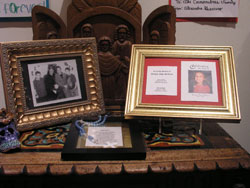Exhibit celebrates lives of children who died too soon

Photo caption: Photographs at a “Day of the Dead” exhibit at the Indianapolis Art Center pay tribute to four children from two parishes who died in the past five months.
By John Shaughnessy
Caroline Mecklin knows the pain and confusion of losing a friend during childhood.
So when four children from two nearby Indianapolis parishes died in the past five months, Mecklin wanted to find a way to help students at Holy Cross Central School and St. Philip Neri School celebrate the lives and mourn the deaths of their friends.
As the art teacher at Holy Cross, Mecklin followed the year-and-a-half struggle that 9-year-old Soraya Amy Jackson faced with brain cancer before the Holy Cross student died in September.
She also knew the shock and the heartbreak that overwhelmed St. Philip Neri Parish and the city of Indianapolis when 11-year-old Alberto Covarrubias,
8-year-old David Covarrubias and 5-year-old Luis Albarran were murdered, along with four adult relatives, during a robbery in their Indianapolis home in June.
“Most of the students knew the children, and it affected them deeply,” Mecklin said. “We wanted to find a way to invite the children to understand life in relationship to death, without telling them what they should be thinking.”
So Mecklin joined with St. Philip art teacher Tosca Marin in helping students at both schools tap into the Mexican tradition called the Day of the Dead, a celebration that remembers the lives of the deceased on Nov. 1—All Saints Day—and Nov. 2—All Souls Day.
The students created an altar in memory of their friends, decorating it with items that reminded them of the four children. The altar is now on display through Nov. 26 at the Indianapolis Art Center, one of the places where Soraya Jackson took art classes.
“When children pass on too soon, it’s more of a tragedy,” Marin said. “The murder of the family occurred at the end of the school year, and we never got to talk about it in school. The kids were in shock. This is an opportunity for them to be able to express themselves. I think it helps because we’re supposed to remember that the people who have died are still part of us. In remembering them, it helps us heal.”
Helping with the altar had that impact on the students. As part of the display,
11-year-old Alexandra Guerrero wrote a letter that included this tribute: “I wish God would always shine down on me, to always have the Covarrubias family in my heart. Keep Alberto shining down on me always. Alberto was a good friend of mine.”
Another student from St. Philip Neri School also thought the display was a special way to remember the children.
“It was fun. We got to incorporate art, and it meant a lot to me,” said 13-year-old Marlena Webb.
So did a moment that happened as the students were installing the altar at the art center.
“One lady came up and asked about it,” Marin recalled. “She was really taken by what happened to the family [that was killed]. It was interesting for the students to see how much she cared. The kids at St. Philip are from families that are mostly Hispanic and poor. They need to know somebody cares.”
Mecklin knows the pain personally. As a child, she grew up in a small town with a girl named Wanda that she met at Sunday school.
“She got some kind of illness,” Mecklin said. “We prayed for her in church and she died. My parents took me to her funeral, and it affected me very much at the time.”
It was just the beginning of the heartbreak Mecklin has experienced. Twenty-eight years ago, she became the mother of twin girls who were born prematurely. Madeline lived for just one day. Margrete lived for four months and six days.
“It was devastating to me,” she said.
So was seeing her 86-year-old mother die of cancer on Halloween five years ago. Still grieving a year later, Mecklin created a Day of the Dead altar in memory of her mother, Rose Langer.
“There’s a process of grieving that ties in with the Day of the Dead, with remembering the person and reliving all the things that had been meaningful for them and you,” said Mecklin, the mother of two grown children. “It’s part of the process of grief. The altar is a public acknowledgment of their lives. You’re missing the person and not wanting their presence in your life to end. It becomes a way of celebrating their life and bringing them back to you.”
Mecklin believes it’s an important lesson for everyone to learn, including children.
“In our society, we try to shelter children from the whole concept of sadness,” she said. “But, ultimately, death happens to all of us. As a teacher and an artist, being able to introduce students to the entirety of life—the sadness and the joy—gives children a sense of what it is to be human in all its ramifications.
“From my own experience, what they’ve done here will help them through a difficult time later in their life.” †
